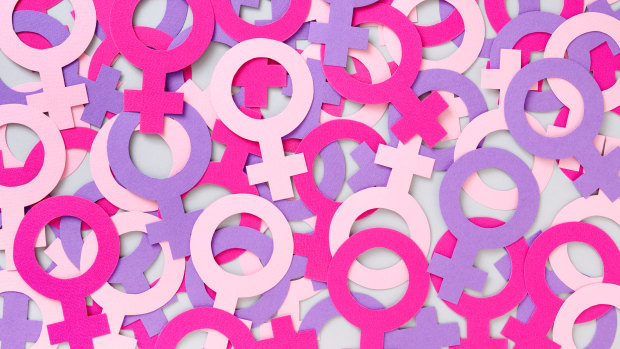- Special Series
- National
- Women in 2021
This was published 3 years ago
‘Girl boss’ feminism turns a movement into T-shirt slogans
By Marnie Vinall
Feminism, once deemed a dirty word by the mainstream, has since been co-opted by the corporate world and given rise to a series of slogans printed on sweatshirts and seen in Instagram hashtags – all in the name of “leaning in” and being a “girl boss”.

Feminism, once deemed a dirty word by the mainstream, has since been co-opted by the corporate world.Credit: iStock
Just look at the slew of girl boss-themed products you can buy at any number of online stores, including ‘Boss Lady’ pens, notebooks and candles, or a pink ‘Girl Boss’ hip flask. There are even lifestyle brands selling clothing for female entrepreneurs, such as ‘Girl Power’ tote bags and ‘Babes Empower Babes’ T-shirts. I’m sure you’ve also seen the ‘Future is Female’ T-shirts, ‘Boss Bitch’ mugs and ‘Get It, Girl’ laptop stickers.
Since its inception, feminism has been about striving for political change and challenging cultural and structural inequality, such as worker’s rights, the right to vote or access to safe abortion.
While it’s crucial to note that earlier waves of feminism had fundamental problems with inclusivity and intersectionality, they were centred around organising and unifying to campaign for law, policy and culture change.
This new brand of feminism, however, is about individual success and power. The term ‘girl boss’ is defined by The Free Dictionary as “a confident, capable woman who pursues her own ambitions instead of working for others or otherwise settling in life”. Unsurprisingly, the ‘girl boss’ is usually equipped with the economic and social privilege to do this.

Since its inception, feminism has been about striving for political change.Credit: Alamy
The problem with this idea of personal ambition and aspiring to reach the top of the ladder is that it places personal achievements ahead of progress for the group as a whole. Instead of listening to others, learning about issues of inequality and campaigning against them, women are told they must take up as much space within the structures that already exist, rather than challenge them for the better of everyone.
Although the idea that women can achieve anything they want has its value, it becomes an issue when it overshadows structural and systematic inequality – disproportionately faced by marginalised women – and exploits others in its pursuit. Furthermore, it’s exclusive, far from intersectional, and deeply capitalistic. In other words, welcome to white feminism.
US writer Koa Beck, in her book White Feminism: From the Suffragettes to Influencers and Who They Leave Behind, notes that mainstream feminism – often presented through a white, heterosexual, able-bodied lens – frames the individual rather than the collective as the agent of change. “All you need is a better morning routine, this email hack, this pencil skirt”, writes Beck, rather than addressing systematic inequalities of labour.
Meanwhile, Beck notes that “feminism built by women of colour was founded on the idea that they would fight racism, classism, and embrace anti-capitalistic ideals. They knew, intuitively as well as ideologically, that if you were operating from a lens of money, you would inevitably leave a lot of people out.”

Mainstream feminism – often presented through a white, heterosexual, able-bodied lens – frames the individual rather than the collective as the agent of change.
The new brand of feminism is undoubtedly seductive. When I was 22, I fell victim to this movement myself and attended a very pink, corporate International Women’s Day brunch in a ‘Feminism’ shirt I bought days before for it. The T-shirt was stocked by a large retail outlet, which I later discovered receives a mere C+ grade in a report rating companies’ efforts to mitigate risks of forced labour, child labour and worker exploitation (in an industry that is predominantly female). That day, I proudly wore that shirt to the event without once thinking about the workers’ rights of the women who made it.
The ‘girl boss’ notion also dangerously evokes the sense that failing to rise to the top is the individual’s issue. I once found myself in a conversation with a (white, middle-class) female co-founder and managing director of a company who was angry that more women weren’t stepping up to top managerial roles. She had made it to the top, so why hadn’t others? She blamed women for not having enough courage and diligence. Not smashing the glass ceiling was, to her, a personal problem and not a systemic one.
You may also ask (as I often do), isn’t the term ‘girl boss’ kind of gross anyway? Isn’t putting the term ‘girl’ in front of a title such as ‘boss’ deeply patronising? If I ever make it to a CEO position of a company, please, please, never refer to me as a SheEO.
Marnie Vinall is a freelance writer.
Ahead of International Women’s Day on 8 March, The Age is publishing a series of pieces by prominent writers looking at issues facing women 2021.